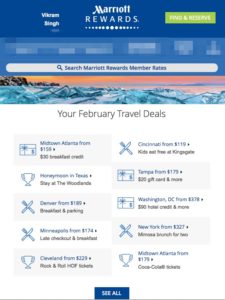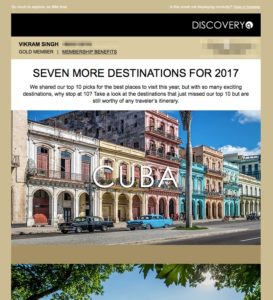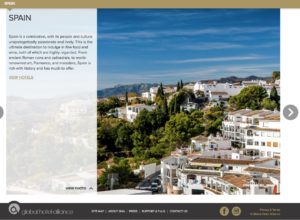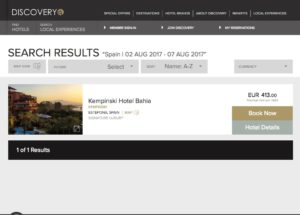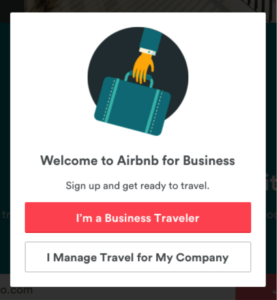
By Vikram Singh
Hotel email marketing has become more important than ever. The cost of click- and impression-based marketing on search engines and social networks continues to rise, not just for generic terms, but also for the historically cheaper brand name terms. Email marketing remains extremely relevant and cost-effective. It has become the best permission-based outbound tool in your marketing kit, hands down. However, as with every great tool, the responsibility to use it well lies with the user.
Smart hotels and brands have moved away from the mass broadcasting of spammy emails, and are now focusing on personalized, permission-based email delivery; and they are seeing their revenues go up. It’s time for you to do the same. This is my guide to email marketing done right.
No Plan = No Revenue
Email marketing cannot be an afterthought. There is a tendency for marketing departments to devote a ton of time to their paid marketing efforts, to the exclusion of almost everything else. Since money is being spent on buying traffic, everyone is focused on getting the best return on their investment. The fact is that your permission-based database of emails is as important and relevant as any other marketing channel. Just as you plan your paid marketing spend, you should also plan your earned (permission-based email) marketing efforts. Most hotel and travel email marketing campaigns still exist as low-level items on someone’s checklist of things to do. Invariably, the marketers who put the least amount of effort into email marketing will end up using one of my least favorite sentences in hotel marketing: “It does not work for us.”
Segment or Perish
Before any effort has been put into the content and design of your email campaign, you have to do some strategic planning. The most important and very first step is to segment and define your audience. I dislike mega lists (aka, “everyone gets the same email “). So, unless your hotel is changing its name, brand, ownership, or shutting down…you have no acceptable reason to send everyone in your email database the same exact message!
I have pushed the agenda of data segmentation in the hotel industry for years, and email lists are no exception. Here is an example of how a typical hotel email database could be segmented in a full-service hotel offering food and beverage outlets, spa, and meeting space:
- Newsletter/Blog Signups
- Deals and Specials Signups
- Guest Who Booked a Room
- Guests Who Cancelled A Room
- Guests Who Gave Email at Check- in
- Guests Who Gave Email at Check-out
- Guest Who Used Food & Beverage Outlets
- Guests Who Used Meeting Spaces
- Guests Who Used Spa Services
- Referrals
You can also segment by the last time someone interacted with you or opened your last email blast. The more you segment, the better the outcome of your email campaign is going to be. Just like in life, you cannot be all things to all people, all the time. Proper segmentation parts the clouds and makes it easier for you to answer the next crucial question: What are you going to say?
Write Email Content That Wins
Boring and uninteresting content will fail, no matter what medium you’re using. In the case of email content, you should start by thinking about the reason(s) that people subscribed to your list. Here are some common reasons people might subscribe to your list:
- They want to receive deals and discounts.
- They want to learn about seasonal local events.
- They have brand affinity.
- They are interested in your food and beverage experience.
- They like knowing what you are up to.
There are a few ways to figure out what topics most interest your email recipients. You can test different kinds of content, and see which users reply to different types of emails. You can also ask them some questions when they sign up (see below). Once you know their intent, you can match the segmented users to the right content.
I travel a lot for business, and I also travel a lot for fun. As a result, my email address ends up being in a lot of brand and independent hotel databases. So, I get to see plenty of poor email marketing campaigns. For example, Marriott sent me the following email with “deals” for destinations all over the US map.
The problem is that none of these destinations are currently on my radar for travel. You know what’s on my mind right now? Spain! So if you are sending me an email about “Honeymooning in Texas,” I will just delete the email.
Speaking of Spain, here is an example of an effective email, leading to poor content on subsequent landing pages. The email has nice photos, catchy content, and… guess what? One of the destinations on the list (Spain) is on my mind! Everything is good, and I give the section on Spain a click. I give them 100% conversion on their call to action!
Landing Page 1: Things start to crumble. Check out the skimpy content they have provided on this landing page. I get a whopping 54-word summary of Spain for my trouble!
I lower my expectations way down. I guess they are not going to provide any useful information. It’s an inauspicious start, but maybe they have something else for me. Maybe their goal is to showcase their awesome hotel portfolio in Spain! Being the quintessential optimist that I am (ha), I give it another click (View Hotels) hoping for a spread of hotels in Spain.
Landing Page 2: Oh man, I get this. One hotel shows up!
My reward for clicking on your email: Kempinski Bahia in Estepona on the east coast of Spain for EUR 413 a night. I close the window hard… probably setting a world record!
Remember, it’s not just the click that matters. Once you manage to get someone to click through, make sure you give them a reason to stay. Poorly executed content and context will tank your campaign every single time.
A golden rule for writing email marketing content: If you have nothing useful to say, then don’t say anything at all. Every campaign needs to be created with the user in mind. It has to be your #1 priority to reward the people who signed up. They cared enough about what you do to share their email address with you. But this can change with one click at the bottom of your next email.
Treat Your Users Like Royalty
This is something I strongly believe in and act on every day. Anyone who signs up for my newsletter joins what I call my “Super Friends” list. We are no longer just friends… we are now Super Friends. This means that every article I write makes it to their inbox before any news outlet gets their hands on it. Any speaking engagement I get, any personal or professional update worth sharing, goes straight to their inboxes first. I ask them for feedback and get many people writing back with questions, answers and ideas on how to make things better. I answer every single email.
Email marketing is not about standing on a pulpit and filling inboxes with marketing fluff. You have to earn the privilege of having access to people’s inboxes. You can never send bad content that does not benefit your guests in some way (as in my Hotels in Spain adventure above).
What’s is in for them? Why should they open your email, let alone click through to take whatever action you are recommending? Segmentation and intent can help you learn what your subscribers want. Make sure every email from your hotel is about them, and not just about you. What are you doing to bring delight to your readers?
Please Don’t Become Your Own Groupon!
For those who are not familiar with Groupon…they used to be kings of building and monetizing an email database. Then they got into hotels and travel in a big way, and even partnered with Expedia. That partnership eventually fell apart, and finally everything crashed and burned.
Make sure that you do not become Groupon with your email marketing efforts. Don’t get me wrong, Groupon was/is amazing at doing emails. They are always offering a discount because it’s their core business model. But that’s not the right approach for a hotel. “Specials and Discounts” cannot be the only reason you send an email to your hotel database.
Example: A hotel in Miami has emailed me eight times in the past eight months. Every single email has been about a seasonal deal or discount in the range of 25% to 40% off the current rates. That’s absurd! I have been a full rate customer who booked direct with them when I stayed at their property. Why do they insist on bringing me back there at a discount? What if I don’t want or need a discount? Furthermore, I start wondering if there is something wrong with the hotel. Is their experience and quality in decline? If not, then why hasn’t any other hotel in the market sent me eight emails offering a discount?
Look, if the only thing you have to say to your guest list is that you have a “great deal” for them, then your hotel starts to brand itself as a hotel that is on a fire sale all year round. In addition, it looks like the only incentive to return there is a discounted rate. Do not break my cardinal rule of Rate over Value. It’s not going to reflect well in your long-term profit and loss statement.
What’s the Frequency?
It’s not just a great REM song but also a critical question in email marketing. How often do you send an email? Great question! There is no perfect answer for this. A hotel is not a news publication, and nobody wants or is expecting a daily or weekly tap on the shoulder from you. A monthly or bi-monthly schedule is optimal, unless you have something exciting to share. (Note: The excitement is not a 35% off mid-week special rate). Never skip more than one month, as some people may forget that they signed up for your newsletter. People have a pretty short attention span these days, so don’t give them a reason to unsubscribe.
Best in Class Tools
It’s not practical or advisable to send out emails from your own server. There are too many checks and balances in place that will prevent you from getting your emails delivered properly. Instead, go with tools that let you send emails the right way, give you excellent analytics, and help you grow your list effectively. My two favorites are:
Both of these services are highly effective and low in cost. They allow you to quickly send your email messages one at a time to everyone on your list. Both offer a nice dashboard, filters, automation and analytics. To prevent your email from getting trapped in firewalls, they use lots of different IP addresses to send your campaign.
Each has a user-friendly interface that helps you design slick and simple HTML email campaigns, so that your recipient’s email client does not wreck your image and text files. We all have received emails every now and then that do not display properly in the inbox. The culprit: email delivery services that are not using the multipart-alternative MIME format. This format ensures that, if for any reason your guest is not able to view your HTML email, a plain-text version will be displayed in their inboxes.
Neither of these providers will let you SPAM. Get a permission-based email list or go home.
Never Bother the Feds
Never spam. Here is what spam means according to Wikipedia: “Email spam, also known as junk email, is a type of electronic spam where unsolicited messages are sent by email.” In the US, the CAN-SPAM Act 2003 puts the penalty at $11,000 for every offense. That means $11,000 for every email sent out without permission. So yeah, please read this and then hard pass on buying lists, no matter how tempting it is.
Top Metrics of Email Success
Measurement is crucial for all marketing success. Emails provide both marketing and product departments a chance to interact with your guests and other people who are interested in you. It’s important not to get caught up in the “last-click attribution” trap. Instead, focus on these crucial metrics when it comes to measuring your email campaign’s success:
1. Open Rate
Open rate refers to how many people opened your email (as a percentage of the total number of emails sent). Please note that this metric can get corrupted by email clients that auto-open emails. Also note that open rates are tracked using an impression pixel (a 1×1 pixel image); if images do not download onto the recipient’s device, it will not be counted as an opened email. So, instead of chasing the data accuracy unicorn, focus on comparisons with your historical campaigns. Open rates are a report card on your messaging, your content headline and appeal. Here is my quick take on open rates:
Under 20% = Get back to the drawing board. 20% to 35% = Keep going. Be sure you continue to refine and test. Over 35% = Congratulations! Keep winning.
2. Click-Through Rate
This metric gets counted when a recipient clicks on any link you have provided in your email message. Reflected as a percentage, it shows how many people followed your call to action. Definitely a deeper metric than open rate, it validates your relationship with your subscribers. I think 10% is a good starting point for most campaigns. Over time, you should aim for 20% or higher as you fine-tune your message. Chronic low click-through rates almost always point to poor responsive design and a disconnect with your target audience.
3. Unsubscribe Rate
I like to call this the annoyance rate. How badly are you annoying your recipients? You should work hard to minimize this bleed. Keeping it under 0.2% at all times is an industry best practice. Sound the alert when this rate inches upwards, as it indicates you have moved beyond losing touch with your audience. You are now annoying them.
4. Bounces
There are two bounces in email land: hard bounce and soft bounce.
Hard bounce happens when you send an email to an email address that no longer exists. Gmail monitors hard bounces very closely. You must remove your hard bounce emails ASAP before you forget to do so and send another campaign to the same non-existent email addresses.
Soft bounces happen when you send an email to an address that exists, but is either full or not taking your emails. Your emails might eventually make it into their inbox if they open up the space. This not as serious as hard bounce, but should be limited to 2% at all times to keep a squeaky clean list.
5. Revenue
If you have your hotel marketing house in order, you should be able to track revenue from every single email you have ever sent to your guests. This is more relevant for campaigns where your click-through target is getting a booking/reservation. This metric is not relevant for your educational and brand building campaigns.
6. Social Share
This is a fantastic metric. It measures how often your recipients open, read, and then like your email messages enough to share them on social media. It’s a true testament to the awesomeness of your email content and messaging. Sharing is the ultimate compliment you can get, because you are now reaching beyond your permission-based circle without breaking the law!
7. Churn Rate
In life and in email marketing, you cannot make everyone happy all the time. People will unsubscribe. Some will complain and break your heart. Hard bounces over time will add up. A lot of email marketers fail to keep an eye on the churn rate. An average email list will have a churn rate of 20% to 25%. This means that, despite your best efforts, you must always keep your new sign-ups hustle going!
Right People, Right Time Zone
Just like your digital marketing, email marketing must be geo-targeted. Your guests travel from all over the country or even the world. Modern email marketing tools help you avoid the costly mistake of prioritizing your time zone over your guests’. Never opt for a single send time based on email analytics (opens and click-through). Sending emails in the user’s time zone is the best solution. Example: NYC hotels sending email campaigns at 9am their time should know that it’s 6am in San Francisco and 3am in Hawaii. I should know. As a resident of Hawaii I get a lot of 3am emails!
Segment Early, Segment Often
Like voting in Chicago, segmenting early and often is the best practice when it comes to building a great email list. The most successful email list builders in the business use every ounce of data to personalize their emails. Be direct and ask clear, easy-to-answer questions at signup. Visual icons or buttons are better than checkboxes. Do not give the user a multiple choice exam requiring more than a minute of their time. Ask simple, visual questions and continue segmentation as you go. A great example of this is Airbnb’s business travel program:
Autoresponders – Don’t Put Them on Autopilot
Autoresponder is a program that automatically generates a set response, or series of responses, to a particular email address. A wonderful gift to email marketers, right? Well, like anything powerful, it can backfire if not used properly. Here is an example of how autoresponder campaigns can become irrelevant if not set up properly.
In this autoresponder schedule, the recipient receives the following messages, regardless of any behavior or action taken by the recipient. Day 1 starts when the user signs up for your email list.
Day 1: Welcome to our hotel email program!
Day 2: Here are some amazing things about booking direct.
Day 3: Here is a 15% off best available rate deal + exclusive rates for signing up.
Day 4: Apply for our co-branded credit card.
Now if a user/guest signs up and also books a hotel room on Day 1, the rest of the campaign becomes moot. So is there an answer? Of course there is! One word: Filters. An email filter removes people from the Autoresponder schedule based on their actions. Filters are your friends. Autoresponders without filters in place are like cars without seat belts. Any non-linear action by your target user can crash your entire campaign.
Avoid These Top 10 Mistakes
Here is a quick round-up of the most common mistakes. They are easy to fix, but can be detrimental to your hotel email marketing campaign if not addressed.
- Not using a permission-based list
- Using a list you haven’t used in a while (6-12 months)
- Confusing transactional email addresses with newsletter signups
- Not segmenting lists (by intent, location, purchasing behavior)
- Pumping discounts, not value
- Sending massively broad campaign emails
- Not including call to action or education
- Focusing on photos and ignoring typography
- Going beyond 600 pixels in width
- Not testing on multiple mobile devices and email clients
Keep Getting Better at It
There is an unwritten rule for successful email marketing. Every email should be better than the last. Nobody in the travel business understands this better than TripAdvisor and Kayak. Give Kayak your home airport and watch how targeted their emails become. You’ll start hearing about deals on places they know you are interested in based on your search history. It’s not creepy, since they clearly asked your permission when you signed up.
TripAdvisor’s emails also get smarter over time based on what cities and what categories of hotels you have been looking at. This kind of approach is much better than that “lost booking capture” tool your marketing agency is touting. Chasing someone who did not complete a booking is 2005. Anticipating where they are going next is where smart email marketing is going. Knowing where I’m traveling from is a good start, but it’s the destination that matters. TripAdvisor will be happy to show me where to stay and how to get there if they can figure out where I’m headed. As they collect data from on-site behavior and email clicks, the emails get smarter with price and location updates.
Conclusion
Email marketing is about two things: targeted segmentation and a high standard for content. Nobody wants to see mass advertising in their inbox. Successful email campaigns are not billboards for your marketing department. They are targeted taps on the shoulder of someone who actually wants to hear from you. Don’t let this wonderful opportunity for interaction go to waste. Use email to learn more about your guests, your product, and your message. Reward your participants with meaningful interaction. Be helpful and prosper.


